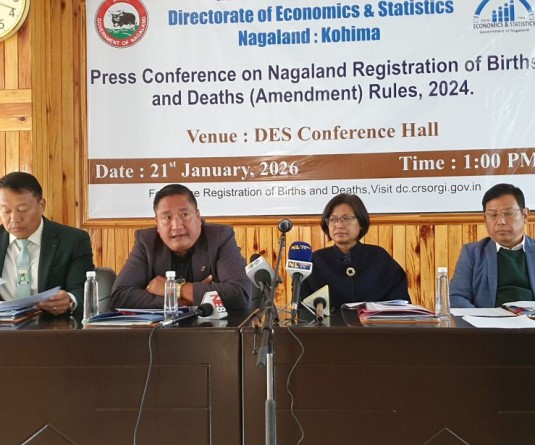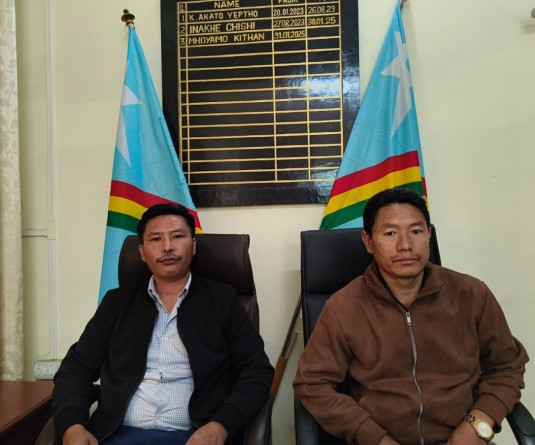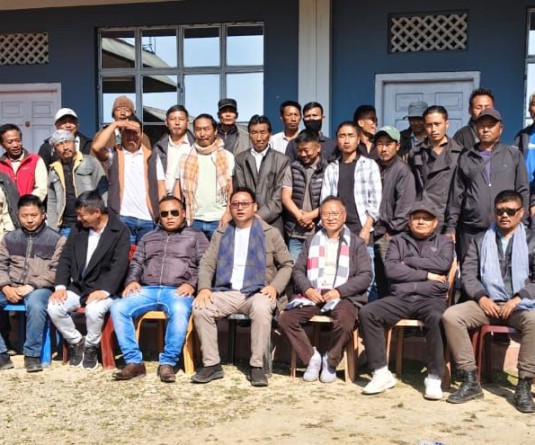A motivational message on one of the posters in Kripa Foundation rehab center.
.jpg)
Atono Tsükrü Kense
Kohima | June 25
The history of substance abuse in Nagaland dates back to the late 80s with rampant use of substance among the youths. Being located along the passage of the Golden Triangle, there was easy availability of drugs in the State, which led to the high rise of substance use.
Due to ignorance, there was time when confrontational tactics were used to weed out substance abuse in the State, which obviously did not help. They were discriminated, stigmatised and punished in the severest manner – beaten, fined, caged in community jail, and even forced to put lock in their ears.
As the world observes the International Day against Drug Abuse and Illicit Trafficking on June 26, The Morung Express spoke to some torch bearers who brought about a whole new perspective in the substance abuse scenario.
Traumatic years
Recounting her experiences, Dr Joyce Zinyü Angami, President Nagaland Medical Council said, “The encounter with chemical dependency was something new in the late 80s to 90s. It a new thing that has happened as far as Nagaland is concerned.”
Dr Angami recalled that during those years, substance abuse was prevalent among younger group of people, particularly students in ‘epidemic proportion,’ where every other house had addiction problem – alcoholism and substance.
“When this new phenomenon happened, the whole society was taken by surprise. As it was something new, they did not know how to react to it,” she said while recalling how substance users were stigmatised, penalised, shamed, fined, caged by the road for the people to see and then declared as outcasts of the community.
Substance dependency rose in parallel with insurgency problems during those years, as Dr Angami recounted, “During that time, there were lots of insurgency problem, so they also tried to intervene in getting rid of anti-social activities. “
Besides beating and imposing fines, some of them were forced to put locks in their ears, not only that they were made to dig their own graves,” she recalled of the confrontational tactics used to get rid of the 'evils' from the society.
Unfortunately, she said, these have not helped one bit, and then the HIV/AIDS came about, compounding the problems, where not only discrimination but stigma had also heightened, with an ill-conceived notion that only drug addicts have HIV.
“The whole of our society, even the churches were full of negativity about them and all these were because of ignorance about drug addiction,’ said Dr Angami.
“The families of substance users have really suffered trauma and anxiety to a point when the children do not come home, they will spend sleepless nights thinking what might have happened, wondering if they would find their dead bodies somewhere. It was so traumatic those days. Those people who walked along with them really suffered,” she recalled with pain.
Crucial role played by Naga mothers
Soon after the formation of the Naga Mothers’ Association (NMA) on February 14, 1984, the Naga mothers found itself up in arms against the chaotic problems of drug addiction among the youth which was creating havoc in homes.
Recounting her journey, Neidonuo Angami, the first Secretary and former President of NMA said, “The first thing NMA felt was the need to fight against the drug traffickers. At that time, Heroin, commonly known as No.4, was easily available from across the Golden Triangle, which passes through the heart of Kohima en-route National highway 39 to go to the rest of the world. This, No.4 was also being easily trafficked at the International border of Tuensang district.”
As this problem was seriously affecting the family systems and the society as a whole, she said the mothers from all localities and villages in and around Kohima were fully determined to fight against the drug traffickers and users in their respective areas.
However, their efforts to weed out drug traffickers in the State were met with challenges as Neidonuo recalled, “In the process, mothers themselves have apprehended some traffickers which had become a problem to the law enforcement agencies. So, we were warned by the agencies not to take law into our own hands.”
Notwithstanding the warnings, NMA continued to encourage and support the police and excise personnel and within a short span of time, she said the kingpin of the drug peddlers was arrested by the Law Enforcement agencies from Dimapur. “Mothers played a big role in that event,” she said with pride and gratitude.
As a token of appreciation and to show solidarity in the drive against drug trafficking, Neidonuo recalled how the mothers of Khuzama village collected a tea cup of rice from every household of the village and donated to the Nagaland Police manning the 1st Nagaland check gate of National Highway 39.
It may be mentioned that recognising the role played by the Naga mothers, the Times of India in its survey report on social initiatives taken by women groups all over India dated June 28, 1994, had cited NMA as “an excellent example” for its role in producing positive results in the fight against drug abuse in Northeast India.
The beginning of rehabilitation centers
While fighting against the drug traffickers, NMA realized that, the addicts had to be rehabilitated. A series of discussion took place during 1987 to 88 with concerned persons and agencies. Finally, this led to the establishment of Mount Gilead Home (MGH), at a rented house in Sechu, (Zubza), Neidonuo informed.
The then Governor of Nagaland, Gen (Retd) K V Krishna Rao inaugurated the Home on February 12, 1989 kick starting the journey of recovery from substance abuse.
Although the counselling sessions started, it could not go beyond reading Bible verses, singing hymns, daily expressions of motherly admonition and praying together.
Sensing the enormity of the crisis, Niketu Iralu, a social activist called Father Joe Pereira of KRIPA Foundation, Mumbai who soon arrived in Kohima with his impressive professional team including a well-known psychiatrist, KRIPA’S senior most counsellor and their policy planning specialist for fighting IT and addiction in South East Asia.
Iralu recalled how he and two members from NMA took the survey team across Nagaland leading to the united conviction of many other mothers from across the State the capacity to fight for the things they held dear, gave hope to their people.
He then went on to be the Resident Manager of MGH, S-Z for six months and also become part-time counsellor and advisor for NMA and KRIPA for a number of years.
Iralu said, “Thus living in the same home with the substance users, available the whole day and night to talk, listen and help in any way, taught me the daily changes I myself needed to accept to enable them to understand the core formula of the recovery programme – HOW: Honesty, Openness, Willingness. They were some of my richest experiences of learning of how to go deep enough to the roots of problems that results in change and healing.”
Case study observations
After years of trying to empower substance users with the knowledge of the substance they are using, Dr P Ngully who has about two decades of working and counselling experience said, “Despite the efforts, they go on relapsing and I realised that medical module alone was not sufficient as it requires a holistic approach.”
“Drug addiction is a part of mental health and it all starts with the mind. It is also a social problem,” observed Dr Ngully and added that many of them had deep seeded psychological pain which they themselves were not aware.
Sharing his observation of case studies over the years, he viewed three common traits/principles on which substance users ‘artistically use’ to sustain their addiction. He said they have the art of manipulation, becomes expert in emotional blackmailing and playing the blame game.
During the treatment, he said they are made to aware of their behaviours, and found that this has contributed a lot to the people who recovered.
“Why addiction is a disease because treatment is available and recovery is possible though it is very challenging. We have to deal with multiple approaches which is more affective, as one module will not suffice,” said Dr Ngully.
He also observed that the society still tends to condemn, stigmatise and be judgemental rather than creating space for them to seek for treatment.
He advised that family and society as a whole should give space in understanding that substance abuse is a disease which is curable, rather than labelling them, and that, parents should show ‘tough love’ in order to cure their wards of this disease.
Iralu’s final observation:“Some of our research scholars must do their PhDs on when exactly heroin from the Golden Triangle entered our Naga homeland through traffickers. We should know who the traffickers were and how they are still operating? How many lives have been lost and how much money our society has had to spend because of the problem? This will reveal to us the size and nature of our crisis.”
“Drugs or alcohol are not the problem. What makes them the problem is the problem,” added Iralu.






